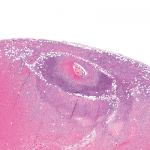Because the patient was outside the window for thrombolytic therapy with tissue plasminogen activator, he was placed on dual antiplatelet therapy—aspirin and clopidogrel.
His condition initially improved, but four days after his initial presentation he awoke with an acute worsening of symptoms. He was treated with 1 g of methylprednisolone daily for three days, and his symptoms (e.g., facial droop, dysarthria, left-sided weakness) improved again. His treatment was complicated by hyperglycemia and steroid-induced psychosis.
Four days after his second episode, the patient had a third stroke. He was given 500 mg of methylprednisolone once and subcutaneous tocilizumab. A repeat MRI showed new acute infarcts in the left pons and extension of the right pons and left cerebellum infarcts (see Figures 1C and 1D).
Two days later, he had a fourth stroke, after which he was nonverbal and unable to respond to commands, and his left upper and lower extremity were flaccid. The patient was transferred for potential neurovascular intervention, but his condition continued to deteriorate, and he died shortly thereafter.
Discussion
GCA is a large-vessel vasculitis that occurs due to granulomatous inflammation and disruption of the internal elastic lamina that line large arteries. GCA is more common in women and people aged 70–80 years old than in men and younger populations. The most common presenting features are new-onset and worsening headaches, jaw claudication and scalp tenderness. Ischemic optic neuropathy is a known complication of GCA, occurring in approximately 7% of patients with GCA.1–4
Because patients with GCA often have concomitant risk factors for atherosclerosis, such as hypertension, hyperlipidemia and advanced age, as noted in our patient, diagnosing GCA-related stroke can be challenging. GCA-related strokes tend to favor the posterior circulation and are more likely to be bilateral than ischemic strokes not related to GCA. Pooling the results of three studies, the vertebrobasilar territory was affected in 73% (39 of 53) of GCA-related strokes.2–4
GCA rarely affects arteries that have passed the dura mater because these vessels do not contain the internal elastic lamina. Compared with atherosclerotic disease-related cerebrovascular accidents (CVAs), in patients with GCA, the middle cerebral artery is the most common site of CVAs (32–44%), and the combined vertebral and basilar territory is affected in approximately 40% of cases, with a slight preference for the basilar artery.5,6
A study focusing on the radiographic features of GCA-related stroke found that intracranial vasculitis most commonly affected the internal carotid arteries, followed by the vertebral artery and posterior cerebral artery, as was the case in the patient described above.7 For this reason, correlation between clinical and radiographic findings through an interdisciplinary team is necessary for prompt diagnosis. Even then, the prognosis for GCA-related stroke is poor because the majority of patients continue to experience disease progression.

